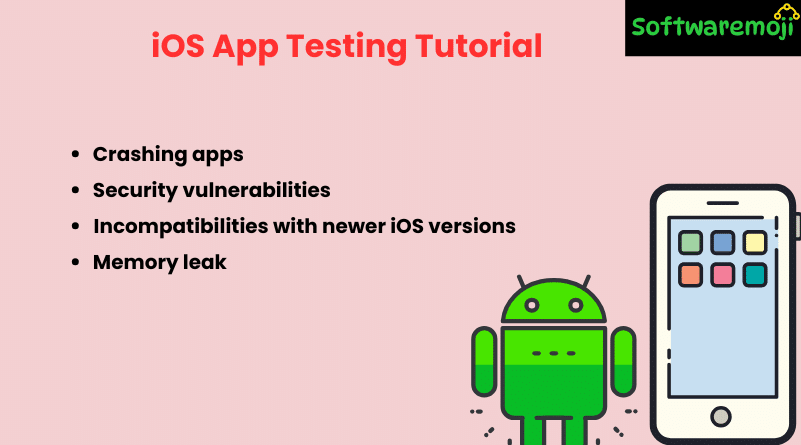👉Tutorial-6: iOS Automation Testing
👉Tutorial-8: Game Testing
👉Tutorial-9: Best Mobile App Testing Tools
👉Tutorial-10: Top Sauce Labs Alternatives
👉Tutorial-11: Best Mobile Application Testing
👉Tutorial-12: What is Interrupt Testing in Mobile Applications?
👉Tutorial-13: Best Mobile App Development Tools

👉iOS App Testing Tutorial
What is iOS App Testing?
iOS App Testing Tutorial: iOS App Testing is the process of testing iOS applications on real Apple devices (iPhone/iPad) to validate their functionality, performance, appearance, compatibility, and behavior. It ensures the app works as expected across various iOS versions and environments.
👉 Why iOS App Testing is Important?
- Apple’s iOS platform is exclusive to Apple devices and doesn’t support installation on non-Apple hardware.
- Even well-designed apps can contain bugs such as memory leaks, crashes, and UI issues.
- Frequent iOS version upgrades can cause compatibility problems in existing apps.
Common iOS Bugs:
- Crashing apps
- Security vulnerabilities
- Incompatibilities with newer iOS versions
- Memory leaks
👉 iOS App Testing Checklist
iOS App Testing Tutorial: Here are key items to verify during iOS mobile application testing:
- Check installation time and ensure the app icon/name reflects the core function.
- Verify splash screen appears and home screen loads within acceptable time.
- Confirm UI responsiveness in both landscape and portrait modes.
- Test app behavior with and without an internet connection.
- Ensure location and push notification permission alerts are shown only once.
- Relaunch app after quitting to verify persistence and functionality.
- Verify app listing in iOS Settings and App Store based on OS compatibility.
- Ensure the app goes into sleep mode when in background.
- Check for progress indicators during slow load times.
- Validate UI consistency and proper use of standard buttons.
👉 iOS Testing Strategies
🔁 Automated Testing
iOS App Testing Tutorial: Automated iOS testing provides faster, repeatable test execution with improved coverage. Key benefits:
- Run tests on multiple devices and SDKs
- Save time and reduce manual testing effort
- Increase testing efficiency and lower development costs
Popular iOS Automation Frameworks:
- OCUnit – Objective-C unit testing framework integrated with Xcode.
- UIAutomation – JavaScript-based testing for iOS simulators and real devices.
- Simulates gestures, taps, and other UI events
- Provides logs and feedback during execution
- Simulates gestures, taps, and other UI events
- KIF (Keep It Functional) – Integrates with iOS accessibility features for automated UI testing.
- Frank – Cucumber-based automated acceptance testing framework.
Pros of UIAutomation:
- Gesture and rotation support
- Device-level testing, not limited to simulator
- JavaScript-based scripting
Cons:
- Not open source
- Limited tool integration
👉 Manual Testing
iOS App Testing Tutorial: Manual testing helps uncover UI issues, edge cases, and exploratory defects.
Types of Manual Testing:
- Exploratory Testing: No formal plan, quick bug detection.
- User Testing: Conducted by real users to get feedback beyond functionality.
Pros:
- Early bug detection
- Minimal setup
- Real-world user scenarios
Cons:
- Low test coverage
- Skill-dependent
- Poor documentation
👉 A/B Testing in iOS
iOS App Testing Tutorial: A/B testing compares two app versions (A and B) to analyze which one performs better based on metrics like user engagement and conversion.
Steps:
- Configure A/B test with two app versions.
- Run the experiment simultaneously.
- Analyze results and release the better version.
Tools:
- Arise – iOS & Android compatible A/B testing framework
👉 iOS Testing Best Practices
- iOS App Testing Tutorial: Always test on real devices for accurate performance and UI behavior.
- Use console logs to trace errors.
- Document bugs using screenshots and crash logs.
- Keep test coverage high using both manual and automated methods.
- Validate compatibility across multiple iOS versions and device models.
👉 Common Myths in iOS Testing
| Myth | Reality |
| iOS and Android testing are the same | They differ in environments, tools, and languages |
| iOS Simulator is enough | It lacks hardware & API support like Camera or Bluetooth |
| More features mean better apps | More features may introduce more bugs |
👉 Conclusion
iOS App Testing Tutorial: iOS App Testing is a crucial process to ensure mobile applications perform smoothly on Apple devices. From manual testing techniques like exploratory and user testing to advanced automation using UIAutomation and OCUnit, this tutorial provides a complete roadmap for developers and testers. A combination of real-device testing, A/B experimentation, and adherence to best practices ensures better quality and user satisfaction.
Click To Open
👉Tutorial-6: iOS Automation Testing
👉Tutorial-8: Game Testing
👉Tutorial-9: Best Mobile App Testing Tools
👉Tutorial-10: Top Sauce Labs Alternatives
👉Tutorial-11: Best Mobile Application Testing
👉Tutorial-12: What is Interrupt Testing in Mobile Applications?
👉Tutorial-13: Best Mobile App Development Tools
